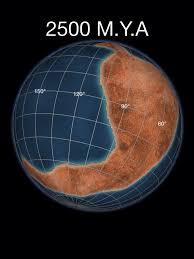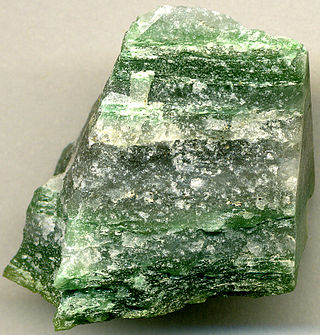Related Research Articles
Giga- ( or ) is a unit prefix in the metric system denoting a factor of a short-scale billion or long-scale milliard (109 or 1,000,000,000). It has the symbol G.
The Precambrian is the earliest part of Earth's history, set before the current Phanerozoic Eon. The Precambrian is so named because it preceded the Cambrian, the first period of the Phanerozoic Eon, which is named after Cambria, the Latinised name for Wales, where rocks from this age were first studied. The Precambrian accounts for 88% of the Earth's geologic time.

A year is the time taken for astronomical objects to complete one orbit. For example, a year on Earth is the time taken for Earth to revolve around the Sun. Generally, a year is taken to mean a calendar year, but the word is also used for periods loosely associated with the calendar or astronomical year, such as the seasonal year, the fiscal year, the academic year, etc. The term can also be used in reference to any long period or cycle, such as the Great Year.

Paleoclimatology is the scientific study of climates predating the invention of meteorological instruments, when no direct measurement data were available. As instrumental records only span a tiny part of Earth's history, the reconstruction of ancient climate is important to understand natural variation and the evolution of the current climate.
The Hadean is the first and oldest of the four known geologic eons of Earth's history, starting with the planet's formation about 4.54 Bya, now defined as Mya set by the age of the oldest solid material in the Solar System found in some meteorites about 4.567 billion years old. The supposed interplanetary collision that created the Moon occurred early in this eon. The Hadean ended 4.031 billion years ago and was succeeded by the Archean eon, with the Late Heavy Bombardment hypothesized to have occurred at the Hadean-Archean boundary.
English number words include numerals and various words derived from them, as well as a large number of words borrowed from other languages.

The Paleoproterozoic Era is the first of the three sub-divisions (eras) of the Proterozoic eon, and also the longest era of the Earth's geological history, spanning from 2,500 to 1,600 million years ago (2.5–1.6 Ga). It is further subdivided into four geologic periods, namely the Siderian, Rhyacian, Orosirian and Statherian.

The timeline of the early universe outlines the formation and subsequent evolution of the Universe from the Big Bang to the present day. An epoch is a moment in time from which nature or situations change to such a degree that it marks the beginning of a new era or age.
Many languages have words expressing indefinite and fictitious numbers—inexact terms of indefinite size, used for comic effect, for exaggeration, as placeholder names, or when precision is unnecessary or undesirable. One technical term for such words is "non-numerical vague quantifier". Such words designed to indicate large quantities can be called "indefinite hyperbolic numerals".
Two naming scales for large numbers have been used in English and other European languages since the early modern era: the long and short scales. Most English variants use the short scale today, but the long scale remains dominant in many non-English-speaking areas, including continental Europe and Spanish-speaking countries in Latin America. These naming procedures are based on taking the number n occurring in 103n+3 or 106n and concatenating Latin roots for its units, tens, and hundreds place, together with the suffix -illion.

Kenorland was one of the earliest known supercontinents on Earth. It is thought to have formed during the Neoarchaean Era c. 2.72 billion years ago by the accretion of Neoarchaean cratons and the formation of new continental crust. It comprised what later became Laurentia, Baltica, Western Australia and Kalaharia.

The Eoarchean is the first era of the Archean Eon of the geologic record. It spans 431 million years, from the end of the Hadean Eon 4031 Mya to the start of the Paleoarchean Era 3600 Mya. The beginnings of life on Earth have been dated to this era and evidence of archaea and cyanobacteria date to 3500 Mya, comparatively shortly after the Eoarchean. At that time, the atmosphere was without oxygen and the pressure values ranged from 10 to 100 bar.
The Indic numbering system is used in the Indian subcontinent to express large numbers. The terms lakh or 1,00,000 and crore or 1,00,00,000 are the most commonly used terms in Indian English to express large numbers in the system.
The long and short scales are two of several naming systems for integer powers of ten which use some of the same terms for different magnitudes.

The history of Earth concerns the development of planet Earth from its formation to the present day. Nearly all branches of natural science have contributed to understanding of the main events of Earth's past, characterized by constant geological change and biological evolution.
Early Earth is loosely defined as encompassing Earth in its first one billion years, or gigayear (Ga, 109 y), from its initial formation in the young Solar System at about 4.55 Ga to some time in the Archean eon in approximately 3.5 Ga. On the geologic time scale, this comprises all of the Hadean eon, starting with the formation of the Earth about 4.6 billion years ago, and the Eoarchean, starting 4 billion years ago, and part of the Paleoarchean era, starting 3.6 billion years ago, of the Archean eon.
Gya or GYA may refer to:

Laurentia or the North American Craton is a large continental craton that forms the ancient geological core of North America. Many times in its past, Laurentia has been a separate continent, as it is now in the form of North America, although originally it also included the cratonic areas of Greenland and also the northwestern part of Scotland, known as the Hebridean Terrane. During other times in its past, Laurentia has been part of larger continents and supercontinents and consists of many smaller terranes assembled on a network of early Proterozoic orogenic belts. Small microcontinents and oceanic islands collided with and sutured onto the ever-growing Laurentia, and together formed the stable Precambrian craton seen today.

The geological history of Mars follows the physical evolution of Mars as substantiated by observations, indirect and direct measurements, and various inference techniques. Methods dating back to 17th-century techniques developed by Nicholas Steno, including the so-called law of superposition and stratigraphy, used to estimate the geological histories of Earth and the Moon, are being actively applied to the data available from several Martian observational and measurement resources. These include landers, orbiting platforms, Earth-based observations, and Martian meteorites.
Billion is a word for a large number, and it has two distinct definitions: